SWG’s CEO Gary Watkins is featured in the December edition of Energy Manager Magazine, discussing how the use of building management systems combined with CMMS will help businesses bring down their energy usage, benefitting business costs and aligning with ESG principles.
As the energy crisis continues in the UK, attention is turning to how businesses can save on their energy usage, both for the environment and for their expenditure. Additionally, with Gen-Z entering the working world with full force, focusing efforts on to ESG targets has never been more important, with 43 per cent of Gen-Z workers stating that a company’s mission, purpose and values are essential for them when choosing an employer.
A recent report from BRITA found that by targeting sources of invisible waste, which includes equipment being left on needlessly overnight such as printers, computers, or air conditioners, businesses will be able to cut their energy levels significantly. 45 per cent of business leaders admit to leaving this type of electronic equipment on overnight, with 65 per cent not even knowing how much energy they are using. It is vital that companies consider how much energy they use and identify ways in which they can reduce this to make energy management strategy decisions.
Integration of Tech
Computerised maintenance management systems (CMMS) can provide detailed insight into energy usage, and solutions to reduce it. CMMS software can already unlock a number of time and cost benefits relating to asset and maintenance management through streamlining workloads and supporting data-driven decisions. This software can monitor energy usage across a building, providing a detailed picture of several areas where inefficiency can be tackled.
One way to access this type of data is by integrating sensors across your building. Sensors allow CMMS to log the occupancy of rooms and other areas of a building. This data can be used to inform strategies around lighting, air conditioning and cleaning, and can even synchronise with room booking software or a building management system (BMS) so that only areas that need be lit, heated and cleaned are done so ahead of time.
This eliminates energy waste such as lights being left on in meeting rooms, or computer systems being left on standby unnecessarily.
It is addressing these several small changes that combine together to create a substantial impact. The Carbon Trust calculations on the issue shows that a 20 per cent reduction in energy costs for a business can equate to a 5 per cent increase in sales for many firms. It is because of this that many facilities management companies are taking on more responsibility to provide good energy management solutions on top of the expected high levels of service.
Optimising Your Assets
Another helpful way that CMMS can reduce energy costs is through greater organisation of asset maintenance. Optimising cleaning schedules, for example, is a great place to start. CMMS systems allow users to mark which areas need cleaning. When a meeting room has been used, it should be cleaned before its next use. Rather than having a schedule whereby the rooms are all cleaned at a specific time, users can tell the system after a room has been used which alerts the operative in real time or in advance that this room needs to be seen to. Alternatively, room booking systems can automatically flag when a meeting is over, and the room needs to be cleaned.
This way, cleaning teams are much more efficient, which saves on energy costs and reduces waste as fewer cleaning products are used and cleaning appliances like vacuum cleaners are not run as regularly. Optimising assets also reduces the need for emergency call outs.
Office devices such as printers, scanners, computers, and monitor displays are “vampire devices” – they consume energy while in standby mode. Turning them completely off when not in use is a good place to start, but ensuring their efficiency is another great way to keep energy costs down. A CMMS can store data about a device’s last maintenance checks, warranties and condition. This insight helps to ensure that appliances are less likely to malfunction or cause issues, meaning their energy usage is at its most efficient. Well maintained assets draw on less energy and managing them to these levels of intricacy can lead to significant savings over the course of a year.
Data is King
Data taken from a BMS is only as effective as how it is used. It is important to work closely with vendors to identify the type of data required to help make cost savings and how best to organise it. Identify the metrics that you wish to track, and how these relate to your organisation’s KPIs and sustainability commitments. Reports and dashboards can be built within the CMMS software to track this information, providing intelligent insight into where energy savings can be made.
A BMS cannot turn appliances off for you, but the data collected can help to advise facilities managers. With the looming threat of potential blackouts and further energy rationing, taking these steps to reduce energy usage through the use of integrated software will see great benefits to the business as well as the environment.
 Australia
Australia






